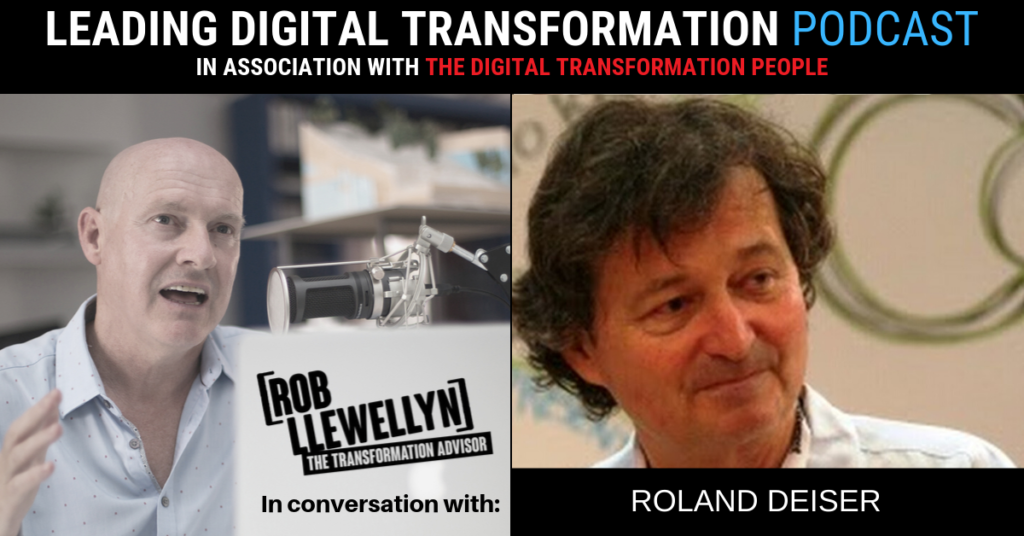How to achieve digital transformation in large and complex organisations: An Interview With Roland Deiser ‘Leading Digital Transformation’ is a weekly podcast series produced in collaboration between The Digital Transformation People and Rob Llewellyn digital transformation advisor and founder of CXO Transform.
During this series, Rob interviews experienced practitioners, authors and thought leaders whose stories and experiences provide valuable insights for digital transformation success.

In this episode, Rob speaks with Roland Deiser, founder of the Center for the Future of Organization, senior Fellow of the Drucker School of Management and author of 2 books “Transformers” (2014) and “Designing the Smart Organization” (2009).
Listen as Roland explains why digital transformation is different from previous transformational events and discusses the ambidexterity challenge, how to achieve agile architectures and why the ability to manage boundaries is a core element in the orchestration of successful transformation.
“I think a great way to create industry leadership is to initiate and facilitate platforms of stakeholders, that you orchestrate, for instance, together with your customers to create a customer dialogue platform about issues that are important to them and create a supplier platform for bringing other stakeholders of ecosystem into conversations. I believe it’s very much about enhancing conversations and dialogue architectures.”
Listen here and read the full transcript below.
Transcript
Rob Llewellyn [00:00:20] Hi and welcome to another episode. I’m joined today by Roland Deiser. Roland is a Drucker Senior Fellow and leads the “Centre for the Future of Organization” at the Drucker School of Management at Claremont University. His current work focusses on the impact of digital technologies, on leadership and organisation, and on organisational capabilities required in disruptive business environments. Roland is also the founder and chairman of the Executive Corporate Learning Forum which is a consortium of more than 50 global corporations from twelve countries, which he created in 2005 to shape the future of transformational learning and development in large organisations. As a keynote speaker, he has been addressing audiences in the United States, Europe, Asia and Australia, and he’s also been working [as an advisor] with global Fortune 500 companies such as Bertelsmann, Credit Suisse, Cisco Systems, Deutsche Telekom, SAP and Siemens, etc., as well as with emerging growth companies, primarily in the digital media convergence space. He’s the author of the books “Designing the Smart Organisation” and “Transformers” and he recently published a research paper on digital transformation challenges in large and complex organisations, which is the focus of today’s podcast.
Rob Llewellyn [00:01:48] Roland, welcome!
Roland Deiser [00:01:50] Well, I’m glad to be here, Rob!
Rob Llewellyn [00:01:52] Hey, Roland. You’ve been working on organisational transformation for a long time. What’s so special when it comes to digital transformation?
Roland Deiser [00:02:02] It’s kind of interesting. Transformation has been around forever actually. Think about the big industrial revolution, things that happened [in this context]. [We are] now in one of those big transformational eras and I believe it’s as big as the industrial one. A lot has been written about this and you could say, “well, transformation, isn’t it always something where you have to go from A to B and is digital [so] different?”. One example way back, maybe 25 years ago, we did some work with a steel company which produced welding wire. They were the super experts in this very highly specialised steel [that you] need to weld [very] difficult components. And they were the big fish in a very, very small market. The whole market was maybe two billion dollars. And they didn’t know how to grow, because they had a 75 per cent market share. And we worked with them and changed their mind[set] in that they’re not in the steel business, [but] they’re in the welding business. And if they’re in the welding business, suddenly the whole stakeholder universe they had to deal with [was] changing. They suddenly had to deal with gas maybe and other kinds of stuff. And all the [specialists] that they had welding steel were still important, but not as important [any more]. And so [a] mindset shift had to happen. That was the big strategic shift for them and back then very few companies were able to do these major strategic shifts. In business transformation today, similar things happen. We have to go from one mindset (in which industry we’re in, which products we’re in, which kind of stakeholder universe we’re in) to a different one. But it’s no choice anymore, you have to do that because digital is so ubiquitous. I would say one thing is, it’s just there, it’s huge and [you can’t escape it]. So that is one thing why it’s different and special. Another one, [the digital world develops] really fast and the acceleration and the exponential speed is incredible. And incumbents who have been there for years or maybe even decades, [their] time frames become shorter and shorter. And it’s very hard to catch up in that speed, because a Start-Up or a new emerging company that starts right now in this moment, will always have an advantage versus those who come [with a] legacy of [an] existing business model. So that is another big different thing in [digital] transformation. And then [what we] witness as well that in times of platforms and global players that [act] beyond national boundaries: [in] the typical [way] we looked at the competition, the unit of competition was the firm, that is also not anymore the case in the digital age. The unit of competition become networks, ecosystems that change and that are fluid, and all the strategic thinking that just wraps around its head about a single organisation doesn’t work in that simple way anymore, so that’s another special thing as well. And last but not least, I believe [we are] in a society that really does not yet know how to deal with digitalisation, we have an institutional infrastructure with the political system, with [a] regulatory system and so on that is based on the industrial revolution. If you look at it, it took 70 years really from the end of let’s say the 19th century when the unions started to configure themselves in the political system. [We] had two world wars and you had the Depression and eventually you ended up with a Pax Americana and the western type of economic and societal structure [today, which is] based on the industrial revolution and gets its contradictions more or less in check. Today we have a digital revolution and we don’t have these ramifications in check yet. We see all those reverberations of issues that happen, how to deal with data, with security, with privacy and so on and so forth. But we still have to figure [it] out. So that makes it very special as well.
Rob Llewellyn [00:06:14] Roland, in one of your recent studies you mentioned three distinct arenas in which digital transformation happens. Can you elaborate on these three?
Roland Deiser [00:06:26] Yes, it’s quite interesting, we looked at that. We did this study where we talked to about 30 or more C-level executives from global corporations, all of them with more than a hundred thousand employees about how these things [are] happening. [There] was a conversation that we had with the CEO of one of the larger business units at Siemens who said “What is digital transformation? [How] can we wrap our heads around that, because everybody somehow has a different association, a different definition”. He said: “To make it simple for our employees, we actually [use] three buckets. The first bucket is to save money. So, we use digital to save money, which means we improve processes, we use technology to make customer interaction more smooth, to just save money. The second bucket is we use digital to make more money, which means we’re enhancing products, we use digital to make products smarter, to make them maybe more attractive, more customer-friendly and so on, but they still remain the products we have. They’re just better products, different products with added value that make more money. And then there is one element of digitalisation that actually creates new money. And that will be really breakthrough disruptive kind of ideas that [take us] away from our original business that opens up new opportunity spaces and that actually really bringing us into new industries and [new customer segmentds]. And by the way interestingly at Siemens here, the distribution was 70 per cent of the project budget for digital transformation went into saving money, about 20 per cent into more money and only 10 per cent towards new money. Having said this, all three [buckets] are important and obviously the CEO said “Well, we’re trying to really grow the share of the new money”. But that’s the hardest thing to do because it’s the most disruptive thing to do. So those are the three buckets we were talking about.
Rob Llewellyn [00:08:36] Roland, you say that to compete in the digital age. organisations need to create an agile architecture. Now, we all use, we all hear the word “agile” bandied around quite a lot these days. But what do you mean by “agile architecture”?
Roland Deiser [00:08:55] We are really using this [expression] a lot. Digital transformation has created a whole plethora of buzzwords. “Agility”, “ambidexterity”, you name it. I mean there’s a lot of new buzzword stuff that goes into the dictionary here. And agility certainly is one of them. I think it’s important to distinguish three elements. One is (and a lot of people do this) is making people more agile, which means agile mindsets, get people a little bit more curious, get people out of their mindset of staying just within the silo of thinking. Agility on a personal level would mean enhancing collaboration between people and so on and so forth. And for that you have training and you go into hackathons and you go into design thinking [workshops], where people go [beyond] their traditional ways and find new ways of being creative and develop things. So, as a person, you become more agile. A second element would be as a team. Right? So agile teams would be a composition of organisational elements that usually would not collaborate but they’re put now together into a team that is cross-functional and that does not go in the traditional process of from A to B to C to D, but where ABCD is already one team and they can work together on a specific customer-related issue. A great example of this is Daimler, [which was] one company we were investigating where they have so-called swarms. Those swarms are multi-functional people that come together to work on specific projects. But the hard thing of these agile teams is that of course they come with people who come still with their own type of departmental thinking. So the team itself needs to become an agile element as well. And that’s more a design issue, how you compose the team and how you then coach the team. And that’s also been a pretty familiar kind of thing. But the third thing I think which is as important, is agile structures. An organisation now has people who have a mindset that’s agile, the teams are cross-functional and everything but still the organisation is not yet able to see how it interacts in a very complex and changing environment. In an eco-system where they have to deal on one hand with very large organisations, on the other hand maybe with start-ups, the third element they have an M&A deal, and the fourth element they have a licencing deal and they have to deal with all these stakeholders in very different ways. This creates a kind of challenge, where you have to have structures that are not any more driven by more or less a central governance, but that requires a lot of independence of peripheral units that then may interact with each other more or less self-organised. Depending on the context, they have to be sometimes very protective. Sometimes they have to be more open. And these agile structures are the third [element] that I believe is important. Together those three create the agile architecture. And I always say if you have great people that are creative and flexible and agile, but you don’t have the structures in which they can thrive, not much will happen. But if you have structures that are enabling people to do these things, it’s already better. But you really have to work on all three elements [to have an] agile organisation.
Rob Llewellyn [00:12:42] Roland, a few minutes ago, you mentioned that of course we’ve got these buzzwords which are flying around these days such as “digital transformation” and “agile”, and another one of those words was “ambidexterity”. I’m glad I said that one correctly! Could you explain what you mean by the ambidexterity challenge?
Roland Deiser [00:13:01] Well the ambidexterity challenge is something that is not really new, right? If you did strategic change and transformation back then it was not yet digital, but you always had to deal with on one hand an old way to do business, an old operating model and then moving towards a new operating model. The example that I had at the very beginning, if you’re into let’s say welding wire as a steel [company] and you’re connected very much in the industry vertical of creating [speciality] steel, shifting towards being a service provider in the enlarged welding industry, means a very different type of organisation and operating model. And going from A to B means you have to really manage both sides on the way. In digital, we’ve been talking a lot that the world of innovation and exploring new opportunities requires a different type of organisation than staying in the old traditional operating model. Now each and every transformation has the challenge: you have to still excel in the present in order to make your money and to sustain, while at the same time you have to create for the future. Those are very different mindsets and it’s a challenge to mitigate them. And there have been a lot of efforts and solutions to do that. Some say it’s important to keep both worlds of innovating, whilst exploiting the existing one under the same roof. Others say well they’re so different, you have to keep them separate and only then bring them together at a later stage. I personally think it’s even more than that. In a conversation I recently had with a colleague of mine from Shell, he said (and I like it a lot): “It’s not about ambidexterity only, it’s really “poly dexterity”, which means it’s not only two operating models, not two mindsets you have to deal with. It’s a multiple set of mindsets. It’s a mindset where sometimes if you work with a Start-Up in an early stage, it’s very different than if you work at maybe with a Start-Up that has now suddenly (through funding and blitz-scaling) created a huge presence but is still a kind of a start-up kind of culture. Then you deal at the same time maybe with a manufacturer that is in, let’s say, a very traditional [commodity] business which is important for you as well. And each of those deal relationships that you have requires a different way to operate. And we’ve seen it, just one example, the last one here, for instance in the famous [transformation] of DVD moving towards streaming. There are still DVDs sold. And DVDs require a very different way of distribution and retail relationships than streaming and you’ve got to somehow mitigate those two. How do you integrate them and how do you [separate] things? But then at the same time, we see already now in streaming that Netflix today, for instance, is suddenly threatened by the studios catching up and Disney [and others] launching their own streaming service. So, we will see that the old operating model of Netflix streaming might have to be rethought again. It’s not only one. It’s multiple models you have to deal with.
Rob Llewellyn [00:16:33] Roland, I know from some of the work you’ve done that the concept of boundaries and boundary management play an important role in your thinking. Firstly, before we get onto the “why”, can you explain to listeners what is the concept of boundaries and boundary management and then tell us why it’s important?
Roland Deiser [00:16:54] [I’m glad you brought up the subject.] I was always fascinated by boundaries, because boundaries are the place where change [really]happens, where development happens. Boundaries are where different worlds collide and out of the difference something new can develop. And this is true for boundaries on all levels. Think about the boundaries of your own mind, right, your own kind of cognitive map that you have. There are certain boundaries and if you don’t challenge these boundaries on a daily basis, you stay more or less in a pretty restricted space and you cannot really learn. Learning is really always dealing with your own cognitive boundaries, maybe emotional boundaries. But then if you go into more complex systems, the boundaries that constitute for instance marriage. [It’s] interesting to look at these boundaries or think of boundaries that constitute a team. And [all] these systems tend to try to be silos. They try to keep themselves secure. The reason is that boundaries have this important function of securing identity, security and so on. But at the same time, they constrain us. And it’s true that if you look at larger organisational boundaries, at industry boundaries, they always keep our minds within a certain kind of confined space. And we have to challenge them, because this is the only way we develop and we learn and it’s the only way to become (as we said before) “agile”, because if you don’t challenge the boundaries, these things don’t happen. Now luckily enough, if we design boundaries in a way – today there is this [expression] “fluid boundaries”, way, way back I called them “semi-permeable boundaries” so they have to be a boundary, but you still provide that safety, that identity that you know who you are. But at the same time, you have to make them fluid. You have to be able to collaborate across those boundaries. And in digital transformation and in the digital contexts of those ecosystems you’re working in today, one of the biggest challenges is really how to decide the degree of openness of these boundaries you want to have. Are you sharing your IP? Are you collaborating and co-creating? Or are you trying to do it yourself? And there is no simple answer to this, because from situation to situation you may choose on one hand to be more closed, in the next relationship you’re more open. And the third one, you totally open up yourself and that is something which is one of the big strategic challenges of designing your boundary architecture. So that’s how I see the importance of boundaries.
Rob Llewellyn [00:19:44] Roland, I want to dig a little bit deeper on that, because you’ve explained the concept really well and why it’s important. This is a really difficult one, isn’t it? How do we get organisations to not operate in these silos so much? How do we get them to move in the direction you’ve just explained?
Roland Deiser [00:20:01] Well, I think it’s very much an organisational design issue. In one sense, I say you have to create institutional mechanisms that make sure that people go across boundaries. Many organisations are designed in a way that reinforce boundaries rather than actually encourage cross-boundary collaboration, because only if you start to collaborate across boundaries can you even decide the degree of openness you want and you need and that’s very often also a question of negotiation. I think that technology helps us a lot here these days. We have now social media which forces people to think about that information goes across boundaries relatively easily.[It horizontalizes the flow of information and communication and] it’s really an enabling technology that helps to bust boundaries. For instance, social enterprise platforms are an excellent mechanism that you can use if you use them well. Of course, they come also sometimes with their challenges and dangers. I’ve seen one company, for instance, Otto Group which is a German (originally) mail-order business company that transformed itself very successfully into now being the number two in online retail after Amazon. They have an institutionalised function that is dedicated to ensure networking across boundaries. It’s on a VP level, reporting directly to the CEO, and what they do is nothing else than making sure that knowledge flows easily across those boundaries, between the various businesses. They have over 100 different businesses in their organisation, [in their group]. They connect people, they provide instruments among other things of course also the intranet to enhance this. They broker between people and they really create a network organisation. Of course, you can do policies that help people to go across boundaries. For instance, [by] introducing the swarm concept at Daimler, Dieter Zetsche, who was at the helm of the company for almost 20 years, said “Well, I want to have 20 per cent of my employees working in swarms. And these swarms are these cross-functional, cross-boundary teams”. That’s a big statement. If you do that and say well 20 per cent of my workforce goes now out of those hierarchies, out of those traditional roles and connects into a project type networked organisation. So policies are important. Of course these are also agile principles we were talking about. So there are [a lot of] things you can do to enhance trans-boundary. I love for instance also platforms, collaboration platforms, that you bring up and that’s true by the way not only inside the organisation. I think a great way to create industry leadership is if you initiate and you facilitate platforms of stakeholders, that you orchestrate, for instance, together with your customers: create a customer dialogue platform about issues that are important to them, create a supplier platform or bring other stakeholders of the eco-system into conversations. I believe it’s very much about enhancing conversations and dialogue architectures. And that’s an art rather than a science because it’s very much also related to anxiety because people hold on to their boundaries a lot.
Rob Llewellyn [00:23:36] Roland, there are many key figures which play an important role in transformation. I’m just gonna pick on one. I’ll pick on the Chief Digital Officer which are popular in some organisations and not so in others. What makes Chief Digital Officers successful?
Roland Deiser [00:23:54] The Chief Digital Officer is a [relatively] colourful new invention, right? So [companies say], “well we have got this digital transformation challenge, let’s bring in the wizard who can help us to really do all that well.” And so they hire Chief Digital Officers, [to be in charge of digital transformation, people who should now be] the ones who [manage] the very complex issue of going from a traditional operating model and traditional ways of doing things into these new organisation of the 21st century. The problem is very often the Chief Digital Officer gets recruited out of I.T. because digital is I.T. and so I.T. people should best know what digital is about, which may be true on the technology side. But we know that in digital transformation, technology is maybe the easier part. Right? It’s also a lot [about] social architectures, you have to change mindsets, you have to change operating models. It’s not just bringing in the latest in cloud technology. So Chief Digital Officers to be successful really, they need to be super-multi-disciplinary, super-multi-functional. They have to really dip into functions that currently are differentiated and not under one roof. So, if they drive a new culture of doing work and new skills that you need to succeed in the digital age, they’re actually doing the work of H.R. If they try to help find the CEO a vision where a company could go because of all these opportunities that come up with digital technology, they step into the realm of strategy and vision. I mean they try to create something like horizontal collaboration, [we talked] just briefly about boundary transcendence and stuff like that. They might be in organisational design or in communication. Customer centricity is another important element because digital transformation is an outside-in type of thing where you really deeply have to understand customer value and leverage that co-create things with them. So they’re suddenly in the marketing sphere. So they really have to cover a lot of ground [here]. And the big challenge for Chief Digital Officers is if they do that successfully, it becomes a highly political function, because they step on the toes of existing people who say “Well, strategy is my territory”. Or “H.R. is my territory” or “Marketing is my territory”. So how can they do that? One example is Christian Langer who is the Chief Digital Officer of Lufthansa. He’s got a different title but in fact that’s what he does. He said, “I can only do this job if I get a board of the most powerful stakeholders that come from various functions, [ones] that I can rely on and that is my kind of community, [one] that works together with me to do these things.” So it’s an important thing to really bring the stakeholders [around] one table and then really foster the conversation among those stakeholders [about] what’s important, and not try to command and control as a Chief Digital Officer. It’s really [about] enabling a flow of different perspectives and changing the mindsets and making the boundaries more fluid in the process.
Rob Llewellyn [00:27:33] Roland, this is something we could probably talk about for hours, but I’m afraid we’re going to have to wrap it up there. Listen, you’ve talked about a lot of concepts in this episode. Where can people go to learn more about these concepts?
Roland Deiser [00:27:49] Well, we have a centre which is called “Center for the Future of Organization”, which is here at the Drucker School of Management at the Claremont Graduate University and we’re building a body of work around the issue of how [the] digital [age] changes leadership and organisations in the world. The project that we actually spoke about in this episode most was the first one we really did on large global corporations, [investigating] the challenges they see in digital transformation. Our next project we’re currently working on is [about] digital business eco-systems, how to shape them and how to succeed in them and [finding out] what are the capabilities organisations need to really successfully leverage and shape the ecosystems in which they for better or worse have to exist and to thrive. We also do some work on how social media is transforming social technology better, how social technology is transforming organisation and leadership. If you go to https://futureorg.org/ that’s our website, or [you can search for] “Center for the Future of Organization”, you will find some material there that you can download. We are also [about] to launch a platform, a dialogue platform, a global one, where people can participate in a series of conferences and events and also [via an] online platform we’re planning to enhance the conversation about these really important issues that shape the future of business and society.
Rob Llewellyn [00:29:28] That sounds really interesting and I’ll make sure that we include links to those in the show notes. Roland, it’s been an absolute pleasure speaking with you. Thank you so much for your time.
Roland Deiser [00:29:38] Thanks Rob, it was a pleasure for me too, thanks.
Announcer [00:29:43] We hope you enjoyed this episode of “Leading Digital Transformation” with Rob Llewellyn and The Digital Transformation People. Visit www.thedigitaltransformationpeople.com to secure the knowledge, talent and services you need for digital transformation success. To continue your journey as a certified transformation professional, visit www.RobLlewellyn.com. Be sure to subscribe to the podcast and follow us on Twitter @TheDigitalTP and @RobertLlewellyn
Article by channel:
Everything you need to know about Digital Transformation
The best articles, news and events direct to your inbox
Read more articles tagged: Featured, Organisational Design






